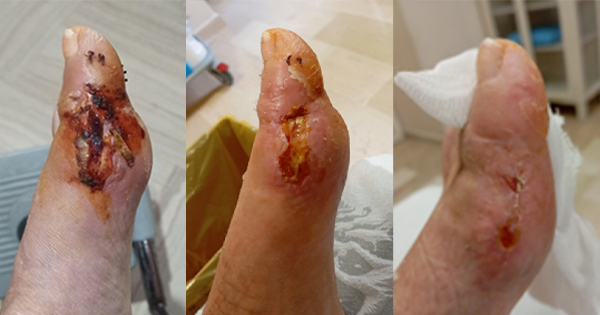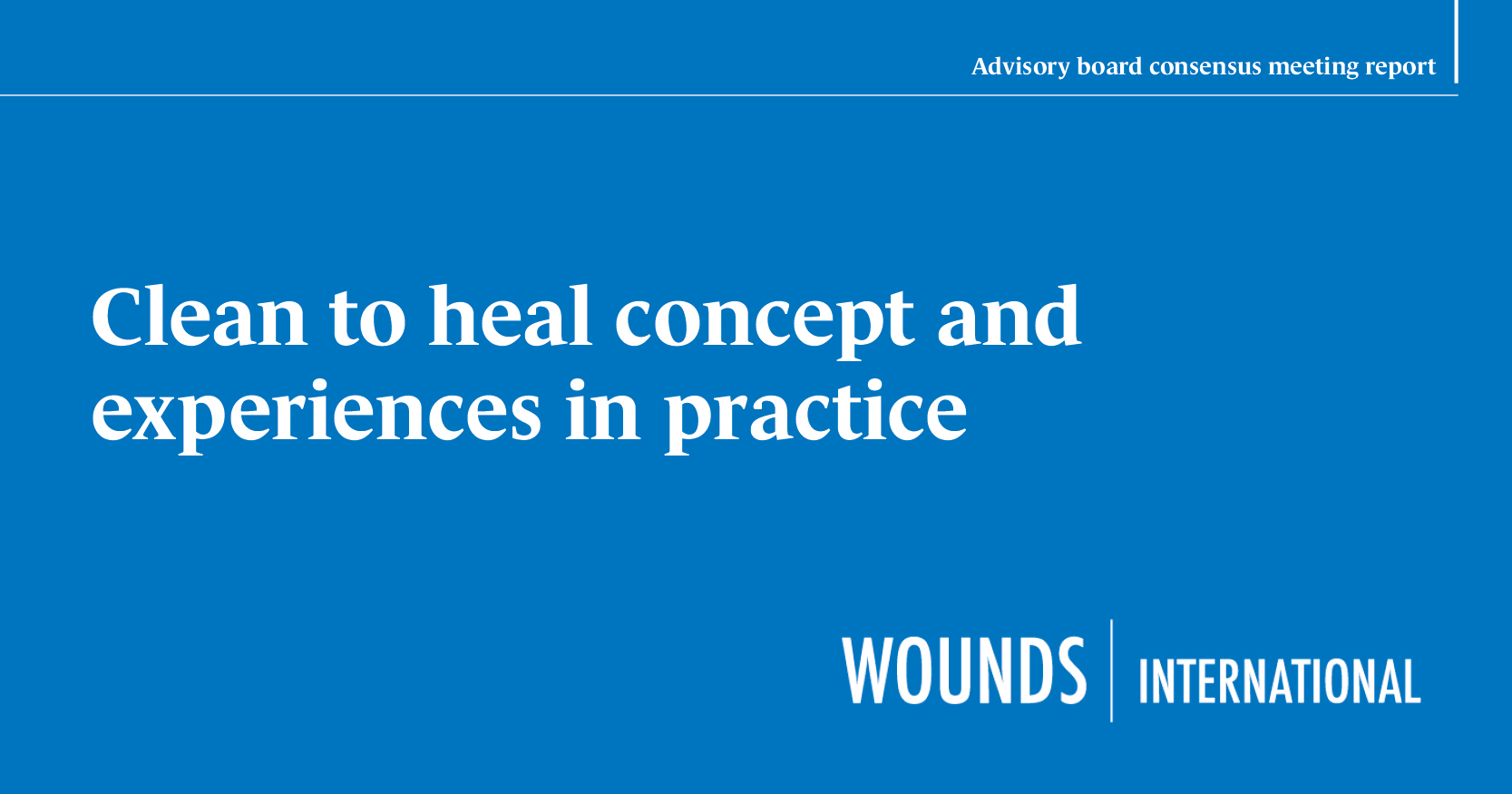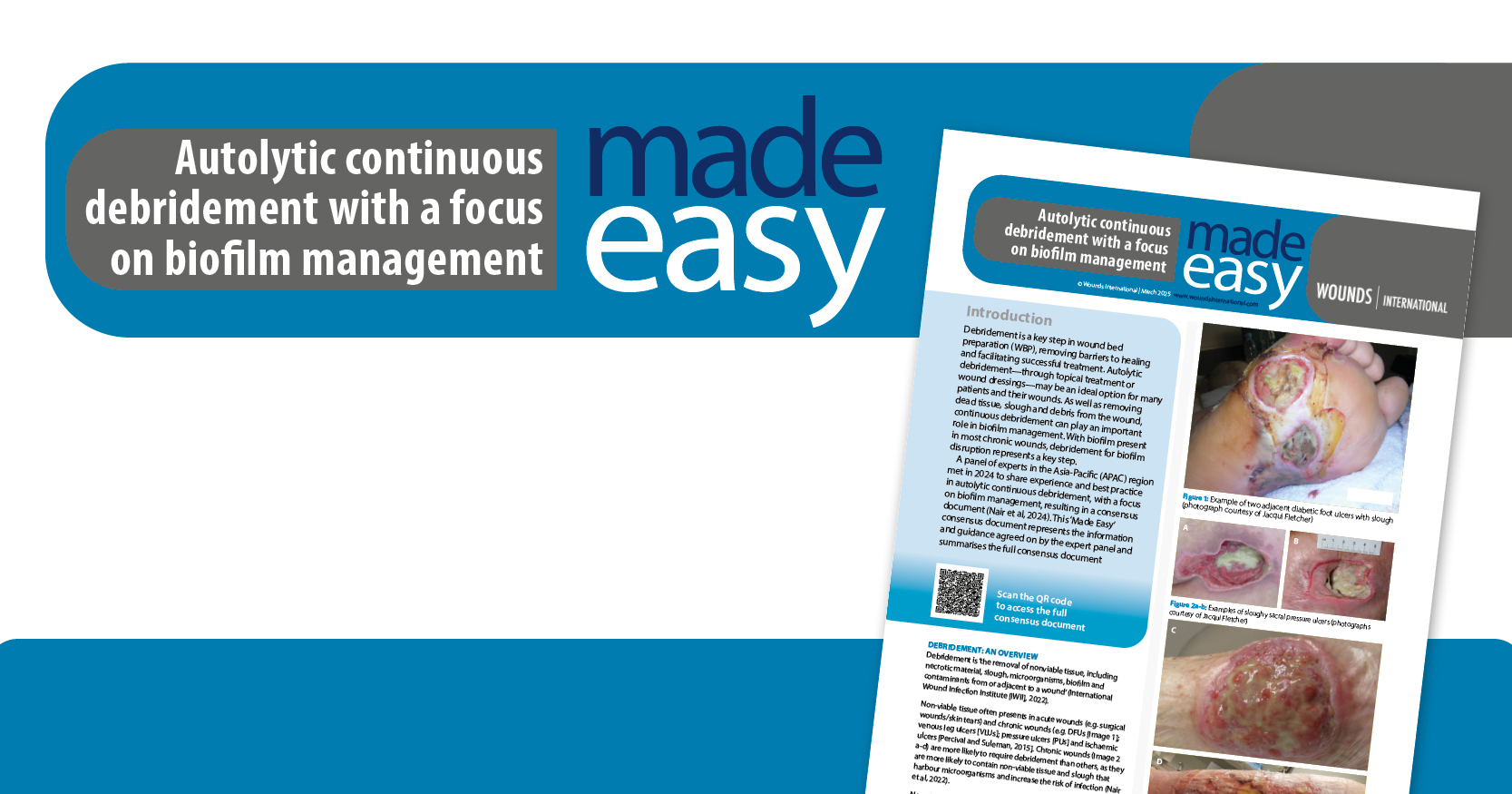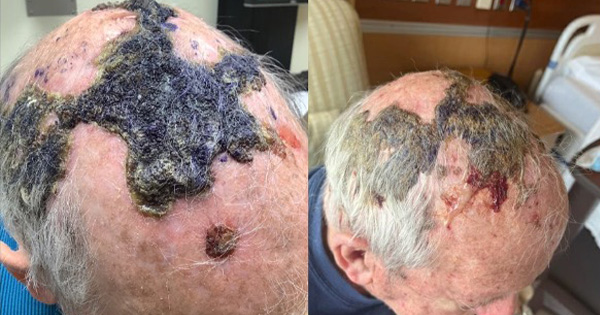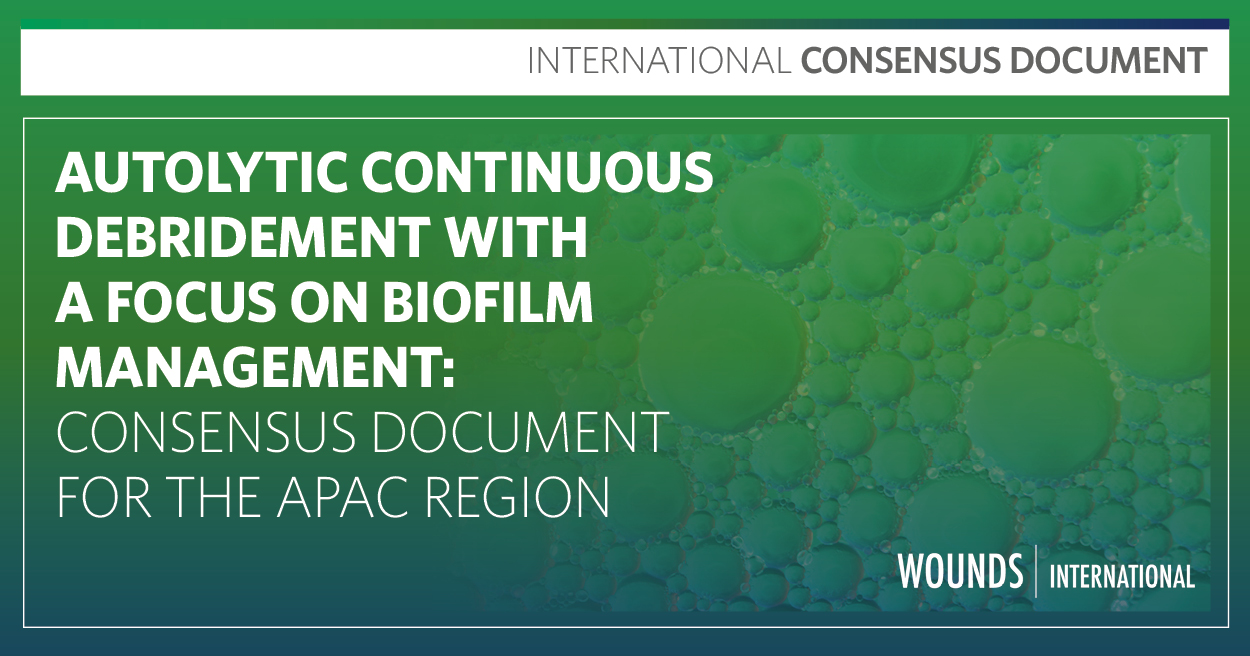The notion of a need for a paradigm shift in wound care through the application of the wound bed preparation (WBP), has been discussed in literature since its inception by Falanga (2000), Sibbald et al (2000), and Schultz et al (2003). It focuses on the optimisation of the wound bed conditions to enhance healing by identifying and addressing barriers of wound healing to create an optimal therapeutic wound environment (Schofield and Ousey, 2021).
The WBP has been updated numerous times. For example, the Debridement/Infection and Inflammation/Moisture balance/Edge effect (DIME), has last been updated in 2021 (Sibbald et al, 2021), while the Tissue, Inflammation/Infection, Moisture balance, Edge of wound/epithelisation (TIME), has evolved to become TIMERS by adding repair or tissue regeneration (R) and social factors (S) (Atkin and Tettelbach, 2019).
Tissue management and debridement have also been a topic of much debate, and a consensus document from 2024 (Mayer et al, 2024), deep dives into this very important step of the WBP to enhance wound healing. In this document, the panel emphasises the importance of debridement and highlight its critical role in wound management best practice. The panel agrees that debridement can help in the promotion of growth of new tissue, reduction of inflammation in the wound bed and improvement of the effectiveness of topical treatments and, in that way, reduces the risk of infection and promote better wound healing. Interestingly, this document introduces the concept of integral debridement which, the panel state, is a new approach, which involves ‘the combined use of different but complementary methods of debridement on the same wound, as required, to achieve an optimal outcome’ (Mayer et al, 2024).
Dressings to aid debridement
Various dressings have been used in wound care for many years with the intention of aiding in the debridement of slough, including thin films, honey, alginates, hydrocolloids and hydrogels (Dabiri et al, 2016). Among the more contemporary dressings, polyabsorbent fibres have been shown to be effective in continuous debridement of slough, without requiring specialist skills to use (Nair et al, 2024). Polyabsorbent fibres (Magnet Fibres, Laboratoires Urgo, Chenove, France) enables the continuous debridement of slough (IWII, 2022), as the negatively charged fibres in the dressing bond to positively charged regions in slough, trapping bacteria and other non-adherent or devitalised material in the dressing, which is then removed when it is changed (Mayer et al, 2024; Nair et al, 2024).
Negative charges are also present in some other dressings, such as alginates and carboxymethyl cellulose-based dressings. The charge densities of these dressings are likely related to their ability to remove slough or debris via physical forces (Chakravarthy and Pernot, 2024). However, the negative charges in the polyabsorbent fibre dressings are likely much closer, and thus much higher in measurable density than in the alginate or the carboxymethyl cellulose dressings, which explains the most likely reason why polyabsorbent fibres are superior with respect to debridement of slough (Chakravarthy and Pernot, 2024).
This superiority was demonstrated in a randomised controlled clinical trial, conducted in 37 centres, to evaluate the polyabsorbent fibres (UrgoClean® Laboratoires Urgo, Chenove, France) compared with a hydrofibre dressing (Aquacel®) (Meaume et al, 2014). A total of 159 patients presenting with venous or predominantly venous, mixed aetiology leg ulcers with more than 70% of slough covering the wound bed at baseline, were included. A detailed wound status was precisely recorded, including location, duration, perilesional skin condition, clinical aspect of the wound bed using a colorimetric scale, a wound area tracing (planimetry) and a wound photograph was taken at inclusion and follow-up visits. Patients were followed-up over a 6-week period and assessed weekly. After a median 42-day treatment period, the percentage of relative wound area reduction (RWAR) was very similar in the two groups. However, the relative reduction of sloughy tissue was significantly higher in the polyabsorbent fibre dressing group than in the control group (-65.3% vs -42.6%; P=0.013, respectively), while the percentage of debrided wounds was also significantly higher in the test group (52.5% vs 35.1%; P=0.033, respectively).
The polyabsorbent fibre dressings are available with different matrices in contact of the wound bed: based on Technology Lipido-Colloid (TLC; UrgoClean Pad®, Laboratoires Urgo, France), TLC with silver sulphate (TLC-Ag, UrgoClean Ag®, Laboratoires Urgo, France) and Lipidocolloid Technology with sucrose octasulfate (or nano-oligosaccharide factor, TLC-NOSF, UrgoStart Plus®, Laboratoires Urgo, France).
Dressings under evaluation
TLC-Ag with polyabsorbent fibres
Polyaborbent fibres with TLC-Ag dressings (UrgoClean Ag®), have been shown in vitro to promote a deeper penetration of Ag+ into biofilm to kill the microorganisms found within it (Percival, 2018). TLC-Ag with polyabsorbent fibres also demonstrated better anti-biofilm activities against in vitro biofilms of methicillin-resistant Staphylococcus aureus and Pseudomonas aeruginosa after 24 hours of exposure than a hydrofiber rdressing, which combined silver, ethylenediaminetetraacetic acid and benzylkonium benzethonium chloride, (Desroche et al, 2016).
Clinical data from a prospective, multicentre, non-comparative clinical trial of 37 patients with chronic wounds, treated with TLC-Ag with polyabsorbent fibres over a maximum period of 4 weeks, showed a reduction of slough (62.5% reduction of sloughy area; 58.8% of debrided wounds) (Dalac et al, 2016).
In a multicentre observational study, involving 2,270 patients with chronic or acute wounds of various aetiologies that were managed with these TLC-Ag with polyabsorbent fibres over a mean duration of 22±13 days, all clinical signs of local infection and diagnosed wound infections were noticeably reduced by week 2, and continued to reduce till until the final visit (Dissemond et al, 2020a).
Observing the direct action of the dressing regarding debridement of slough, all wound types showed a reduction of sloughy tissue slough and an increase of granulation tissue, with an overall decrease of sloughy tissue, from 48±26% at baseline to 22±23% at the final visit. Effective reduction of exudate levels was also reported in 64.1% of patients, in line with the reduction of clinical signs of infection.
It is also interesting to note that, comparing the characteristics of the TLC-Ag with polyabsorbent fibres compared with other commonly used dressings for this indication, according to the physicians’ point of view, the TLC-Ag with polyabsorbent fibres had better antimicrobial efficacy (82.6%), had better debridement of slough properties (85.2%), had easier application and better conformability (68.4%), reduced patient pain (68.9%) and better acceptance by patients (66.8%). (Dissemond et al, 2020a).
TLC-NOSF with polyabsorbent fibres
TLC-NOSF has been shown to reduce excess matrix metalloproteases as demonstrated by in vitro analyses where the TLC-NOSF dressing significantly reduced overall matrix metalloprotease activity when compared with a neutral control (Marconi et al, 2009; White et al, 2015).
Nair et al (2021) identified 21 clinical studies regarding this TLC-NOSF technology, involving over 12,000 patients, including two double-blind randomised controlled clinical trials (Meaume et al, 2012; Edmonds et al, 2018) in diabetic foot ulcers and venous leg ulcers. The authors concluded that the technology offers clinicians with an evidence-based, cost-effective and cost-saving solution in wound management by reducing healing times and enhancing the patients’ health-related quality of life.
In a more recent systematic review, Meloni et al (2024) concluded that the results of the review are aligned with the guidelines recommending the use of this technology and support its wider implementation as a first-line treatment and as an integral part of a standard of care for wounds in the daily practice.
The range of these dressings, which comprises of different formats, including contact layers and adhesive and non-adhesive foam dressings, and also includes a pad of polyabsorbent fibres coated with the TLC-NOSF healing matrix, targeted at use in wounds both at the granulation stage of wound healing as well as wounds at the debridement stage (Dissemond et al, 2020b).
Results of two interventional, prospective, single-arm clinical trials with the TLC-NOSF dressing with polyabsorbent fibres (UrgoStart Plus), showed the investigated dressings to be an effective, safe and easy-to-use treatment for the local management of chronic wounds at the different stages of healing and until wound closure (Sigal et al, 2020). Two prospective, observational, multicentre studies of 1,140 and 941 patients were also conducted to investigate the performance of the TLC-NOSF dressings with polyabsorbent fibres (pad and border and non-adhesive versions). (Dissemond et al, 2020b; Augustin, 2021). In the first study (Dissemond et al, 2020b), by the final visit (maximum duration of 12 weeks), 48.5% of wounds were healed and 48.8% were improved (medianRAWR in all wounds of 97.3%). While in the second study (Augustin, 2021), wound closure or improvement was reported by the last visit (maximum 12 weeks) in 92% of treated wounds, with the highest wound closure rates when the dressing was used as the first line.
Interestingly, the sequential use of TLC-Ag fibre dressing and the TLC-NOSF polyabsorbent fibre dressing has been evaluated by different teams (Vaidya et al, 2024; Al Humadi et al, 2024; Manowska and Szumna, 2024). The authors concluded that these technologies provide clinicians with effective and rapid results (Vaidya et al, 2024), and that the outcomes achieved were satisfactory, with a rapid reduction of clinical signs of infection, slough, exudate and pain, and a rapid wound closure, with no adverse events reported during the course of treatment (Al Humadi et al, 2024; Manowska and Szumna, 2024).
Evaluation of the different polyabsorbent fibre dressings.
Clinicians from different settings in Italy, evaluated the different poly absorbent fibre dressings (TLC-Ag, TLC-NOSF) either as a standalone or in sequence. Eight cases are presented with the different dressings according to wound status. Two cases are managed with TLC-Ag, 1 case with TLC-NOSF, and five cases with TLC-Ag and TLC-NOSF sequentially.
A: Cases with TLC-Ag dressing with polyabsorbent fibres
Case 1 (Courtesy of D’Errico Federica, MD; Baldassarre Veronica, MD; Iacovone Gina, MD. Ambulatorio Infermieristico, Vico del Gargano – ASL Foggia)
A 45-year-old female was referred for a 3-week-old surgical dehiscence post bunion surgery on the left forefoot. The lesion, measuring 3.0 × 0.5 cm, was 80% covered with slough, with moderate exudate, and presence of signs and symptoms of local infection, such as oedema and spontaneous pain.
Due to the pain factor, it was decided to apply the TLC-Ag dressing with polyabsorbent fibres as a primary dressing (with gauze as secondary dressing) to maximise on its local antimicrobial treatment and non-invasive continuous debridement properties of wound debris and devitalised tissue, rather than reverting to sharp debridement.
The dressing was changed twice weekly. A reduction of 40% of devitalised tissue, exudate from “moderate” to “mild” and the surface area of the wound to 1 cm², as well as decrease in reported pain, was noted in less than 2 weeks. The same strategy was continued, leading to the healing of the wound within 25 days.
The TLC-Ag dressing with polyabsorbent fibres allowed for the control of the local infection, the continuous removal of devitalised tissue and debris, and ultimately, the healing of the lesion. This dressing has characteristics that are supportive in contexts where more aggressive debridement techniques, such as sharp debridement, may be not applicable, for example because of a painful wound, need of expertise/licensure, and may also be time consuming and more expensive. The dressing was considered ‘very easy’ to apply by the clinician, and ‘comfortable’ by the patient.
Case 2 (Courtesy of Barbieri Chiara, Wound Care Specialist Nurse. U.O. Chirurgia Generale, ASST Cremona and Maristella Nocera, Wound Care Specialist Nurse, U.O. Servizi per la Domiciliarietà, ASST Cremona)
In 2020, a 73-year-old male underwent an abdominoperineal Mile’s resection, with the creation of a colostomy due to adenocarcinoma in the lower rectum. He was later admitted for sepsis secondary to a parastomal hernia in the left iliac fossa, leading to a median laparotomy, release of the parastomal hernia, colonic resection, and stomal take-down with the creation of a new colostomy on the transverse colon in the right hemi-abdomen.
Eschar, secondary to infiltration of the subcutaneous tissue around the stoma by faecal material, was surgically removed. The cavity wound managed with Negative Pressure Wound Therapy (NPWT), which was applied for 6 weeks, successfully promoted the formation of granulation from the cavity floor, while the site extending to the left hemi-abdomen did not improve as expected and was surgically debrided.
The patient was referred for further management of the extensive lesion that was covered with slough and devitalized tissue. At this point, after cleaning with saline solution and soaking with surfactant solution for 20 minutes, treatment was initiated with TLC-Ag dressing with polyabsorbent fibres, using sterile gauzes and transparent film as a secondary dressing.
The dressings were changed twice weekly. NPWT was continued at the former stoma site for about 3 weeks, with dressing changes once a week: this allowed for a progressively cleaned wound bed and the closure of the exit site of the first stoma.
After another 28 days, the lesion was completely covered with granulation tissue and reduced to about 25% of the initial surface area. The wounds were considered healed by day 86 (minor hypergranulation at 3 o’clock resolved spontaneously).
The use of dressings with continuous debridement and atraumatic removal was crucial in the management of this case. By means of the TLC-Ag with polyabsorbent fibres dressing the clinical signs of infection and inflammation were reduced, promoting an optimal environment for healing. Moreover, minimising trauma during dressing changes preserved the newly formed tissues, reduced pain and improved clinical outcomes. The described approach has been shown to accelerate the healing process and improve the patient’s quality of life, highlighting the importance of these practices.
B: Case with TLC-NOSF dressing with polyabsorbent fibres
Case 3 (courtesy of Suardi Ombretta, MD. Ambulatorio infermieristico Lesioni Cutanee DAPSS; P.O. Magenta – ASST Ovest Milanese)
A 20-year-old woman, with no significant medical history, sustained a bite from her pet cat that ended up with several visits to the emergency room due to the worsening of the wound, notwithstanding administration of antibiotics both orally and intravenously. Subsequently, she underwent fasciotomy for cellulitis complicated by lipo-necrosis. Afterwards, her wound was managed with different types of antimicrobial dressings, and systemic antibiotic therapy, for around 2 weeks.
Following this, the woman ended with a 15 cm × 5 cm × 1.5 cm lesion, mostly covered by granulation tissue and with several centimetres of tendon exposed. At this point, after cleansing with a surfactant solution, TLC-NOSF dressing with polyabsorbent fibres was initiated as a primary dressing, which was changed twice a week. The decision to use the TLC-NOSF dressing with polyabsorbent fibres pad was to promote healing, thus reducing healing time. The wound was healed by day 58. No loss of function of the hand was reported.
The choice of a TLC-NOSF dressing with polyabsorbent fibres allowed a rapid closure of the wound, avoiding the need for a skin graft. Granulation was also facilitated over exposed tendon, where it is usually hard to obtain. The components of the gel-forming matrix, in fact, allows the formation of granulation tissue on the tendon, and has been applied to the tendon itself without causing any damage.
Cases with TLC-Ag dressing with polyabsorbent fibres + TLC-NOSF dressing with polyabsorbent fibres
Case 4 (Courtesy of Gibin Enrico MD, General Surgeon, Chirurgia Generale Presidio Sanitario Ospedale Cottolengo, Torino and Di Bella Federica Registered Nurse, Poliambulatori Centrali Presidio Sanitario Ospedale Cottolengo, Torino)
An 87-year-old female with odontogenic phlegmon, arterial hypertension, dyslipidaemia, gastroesophageal reflux, had a biopsy on right thyroid node. She was hospitalised following the appearance of oedema on the right side of her face and the onset of inability to eat and hydrate orally. Ultrasound revealed an extensive subcutaneous loculation with apparent mobile material inside. More than 200 ml of pus was drained from the loculation. Bacteroides fragilis was present by culture.
Systemic antibiotic therapy was started and continued during her hospitalization, with a local wound treatment of daily rinsing with hydrogen peroxide and physiological solution (5 ml + 5 ml) after which soaking was done with polyhexanide and propylbetaine rinsed with normal saline.
TLC-Ag dressing with polyabsorbent fibres was applied as the primary dressing and a polyurethane foam as a secondary dressing for the management of profuse exudate. Dressings was changed daily. No additional debridement was deemed necessary. This regimen continued for three weeks until the signs and symptoms of infection dissipated. At this point, local wound management was changed to TLC-NOSF dressing with polyabsorbent fibres pad as the primary dressing and sterile gauze as secondary dressing, with three dressing changes per week, and ultimately wound closure has been achieved by day 132.
The treatment of complex wounds does not necessarily require elaborate treatment protocols. The protocol used considers the presence of infection as the discriminating factor, regardless of the condition of the wound bed (fibrin, slough, granulation tissue): the combination of polyabsorbent fibre dressings, with TLC-Ag matrix first then with TLC-NOSF matrix later, allowed for healing of this challenging wound in just over 4 months.
Case 5 (Case courtesy of Gibin Enrico MD, General Surgeon, Chirurgia Generale Presidio Sanitario Ospedale Cottolengo, Torino and Di Bella Federica, Registered Nurse, Poliambulatori Centrali Presidio Sanitario Ospedale Cottolengo, Torino.
A 63-year-old female with no relevant medical history, sustained an extensive dry ice burn on her buttock, which led to the formation of abundant necrotic tissue. A combination of hydrogel and TLC-Ag dressing with polyabsorbent fibres was applied for the complete removal of non-viable tissue from the base of the lesion in a non-traumatic manner, over 12 weeks, initially with daily dressing changes, and subsequently alternate days, using sterile gauze as a secondary dressing. No other methods of debridement were conducted.
This approach led to a 90% increase in granulation tissue versus non-viable tissue, a reduction in exudate from high to moderate levels, a decrease in previously present signs of infection (foul odour, periwound erythema, local warmth, and pain (Numerical Pain Scale [Breivik et al, 2008] drop from 9/10 to 5) and a 16% reduction in the wound area, in the first 30 days of treatment.
TLC-NOSF dressing with polyabsorbent fibres pad was used thereafter, with one to two dressings per week and sterile gauze as secondary dressing. Complete healing was achieved by day 168 (24 weeks).
The availability of easily implementable, but proven effective treatments, can ensure the clinician creates optimal conditions for tissue repair in the most diverse contexts. The distinguishing factor that leads to the choice of one product over another is the presence or risk of infection, the need for continuous debridement, and controlling the inflammatory process, allowing treatment from the moment of patient presentation until complete healing, in conjunction with existing standard of care, creating a treatment approach that is simple and suitable for the most diverse contexts, ensures that the clinician can pursue the objectives of wound bed preparation and restore the healing process.
Case 6 (Courtesy of Parisi Andrea, M.D. – Specialist in Plastic, Reconstructive, and Aesthetic Surgery – S.C. Chirurgia Plastica, Chirurgia della mano e Microchirurgia – Ospedale Maria Vittoria, ASL Città di Torino)
A 55-year-old female, with long-standing type II diabetes, poorly compliant with hypoglycaemic therapy, chronic kidney failure on tri-weekly dialysis and severe obstructive peripheral obliterative arteriopathy, underwent a hemicolectomy for neoplasia in July 2022. In the postoperative days, she developed a necrosis on the dorsal side of the hand at the site of the peripheral venous line placement. Systemic intravenous antibiotic therapy (oxazolidinone) was initiated for about a month following positive detection of Staphylococcus aureus in the necrotic samples removed. The necrotic tissue was surgically removed down to the extensor tendons layer of the hand. The wound was then cleaned with 0.05% sodium hypochlorite before applying the dressing. TLC-Ag dressing with polyabsorbent fibres was applied as the primary dressing, held in situ by sterile gauzes and a soft bandage, and was changed every 3 days. Within 15 days, fibrinous tissue and local signs of infection had been eliminated.
Thereafter, dressing changes were continued on an out-patient setting with the primary dressing now changed to TLC-NOSF dressing with polyabsorbent fibres pad, which was replaced every 3 days. The 0.05% sodium hypochlorite solution was still used as the cleanser of choice. Antibiotics were also discontinued due to the wound improvement.
By day 40, granulation tissue had covered the tendons and, by day 60, enough granulation was achieved to allow surgical placement of a dermo-epidermal graft. Wound was completely healed by day 90 with no loss of hand function.
The polyabsorbent dressings, have allowed for the optimal preparation of the wound bed in a short time, cleansing it of any residual microbial colonies and removing all sloughy tissue that was still present and macroscopically not evident.
This continuous debridement process is essential not only for proper healing by secondary intention but especially in anticipation of a skin graft — the better the quality of the newly formed granulation tissue, the higher the chances of successful graft take.
Case 7 (Courtesy of Prof. Avruscio Giampiero, Dr. Tonello Chiara, Dr. Ragazzo Sonia, Dr. Contarato Roberta Unita’ Operativa Complessa Angiologia, Azienda Ospedale Università di Padova)
A 67-year-old obese woman, with a history of hypertension, type 2 diabetes, and with obstructive sleep apnoea on continuous positive airway pressure, and chronic venous insufficiency, was referred on 4 November 2022 to the wound care clinic for the management of a venous leg ulcer with erythematous periwound skin and a wound bed covered in slough with abundant and malodourous green exudate. After cleansing with temperature-controlled saline solution, local treatment was initiated with TLC-Ag dressing with polyabsorbent fibres, and a multicomponent compression bandage was applied. The dressing and bandage were changed every 4 days.
After 4 days (one dressing change), the slough present at the bottom of the lesion was significantly reduced. Reduction of the periwound erythema and the replacement of devitalized tissue with granulation tissue as well as a reduction of exudate level, viscosity and colour, was evident by the third week.
At this point, the TLC-NOSF dressing with polyabsorbent fibres pad was initiated as the primary dressing, changed every 72 hours, continuing with compression therapy. The wound was healed by day 88 (<13 weeks).
The use of polyacrylate fibres allowed for the progressive and painless removal of slough and debris from the base of the lesion, creating optimal conditions for healing. This continuous cleansing approach is essential to prepare the wound bed for re-epithelialisation, and indispensable if one wants to reduce the healing time of lesions which may otherwise take several months to re-epithelialise. The TLC-NOSF allowed for rapid wound closure.
Case 8 (Courtesy of Prof. Avruscio Giampiero, Dr. Tonello Chiara, Dr. Ragazzo Sonia, Dr. Contarato Roberta Unita’ Operativa Complessa Angiologia, Azienda Ospedale Università di Padova)
An 83-year-old male, with a history of deep vein thrombosis, ischemic heart disease, and type 2 diabetes, presented with a painful (Neuropathic Pain Scale [Breivik et al, 2008] = 9/10) left lower limb mixed arterial venous vascular ulcer of, diagnosed with angiology examination, and instrumental investigations (ecocolordoppler). Systemic antibiotic therapy was initiated after a positive wound swab for Staphylococcus aureus.
The wound was cleansed with temperature controlled saline solution and the TLC-Ag dressing with polyabsorbent fibres pad applied as a primary dressing with alternate day dressing changes. Compression was continued by means of a multicomponent bandage. Rapid improvement in the wound presentation was noted, with a reduction of fibrinous tissue. Furthermore, after 1 month of treatment, the pain score was reduced to 2/10.
Thereafter, the TLC-NOSF dressing with polyabsorbent fibres was applied as the primary dressing, with dressing changes every 3 days. Compression was maintained throughout the treatment.
The wound was completely healed within 5 months.
The continuous debridement of slough and debris from the base of the ulcer by means of the polyabsorbent fibres has shown significant improvement of the wound and the TLC-NOSF with polyabsorbent fibres aided in the ultimate wound closure. It is also important to note that a good standard of care is necessary, in this case, cleansing, compression therapy, analgesia, systematic antibiotic, and the fibre dressings, plays a role in the healing process.
Conclusion
WBP is a concept that has been utilised in wound management for the past two decades. The basics of this paradigm shift is to prepare the wound for closure by identifying barriers to non-healing within the wound, which includes the presence of devitalised tissue, excessive levels of exudate, increased microbial burden, and persistent inflammation (Falanga, 2000; Sibbald et al (2000); Schultz et al, 2003). Evidence-based dressings play an important role, and it is recognised that wound care practitioners need to be aware of the properties and mode of action of products that are available (WUWHS, 2020).
The use of the various polyabsorbent fibre dressings have been showed in a wide range of clinical evidence, highlighted previously, to provide the concepts of the WBP and enhancement of early closure. The high level and amount of evidence behind this technology prompted the authors to evaluate the different formats of polyabsorbent fibre dressings in the management of their patients’ wounds. The wounds presented with different challenges, such as patients with several comorbidities, but also, in some cases, exposed tendons where it is difficult to achieve granulation over these structures.
Although this represents a small cohort, the results achieved were very positive and encouraging and in line with previous evidence, prompting these clinicians to consider including this technology as a mainstay in their wound management standard of care.

